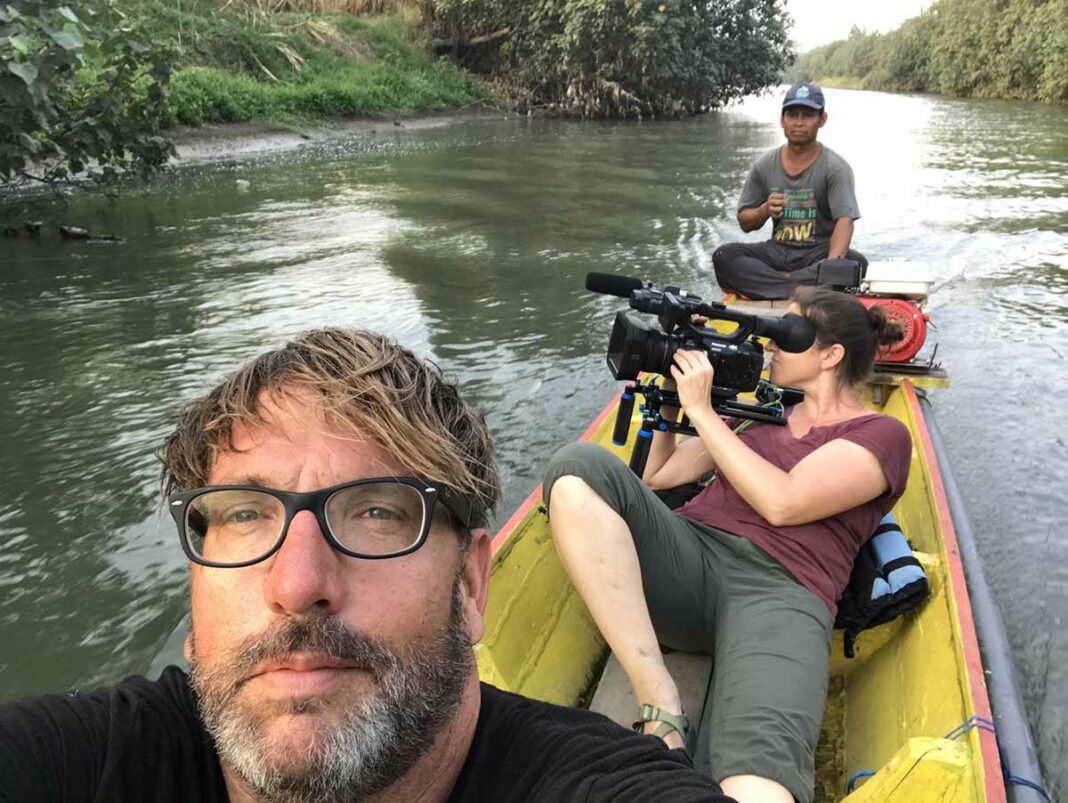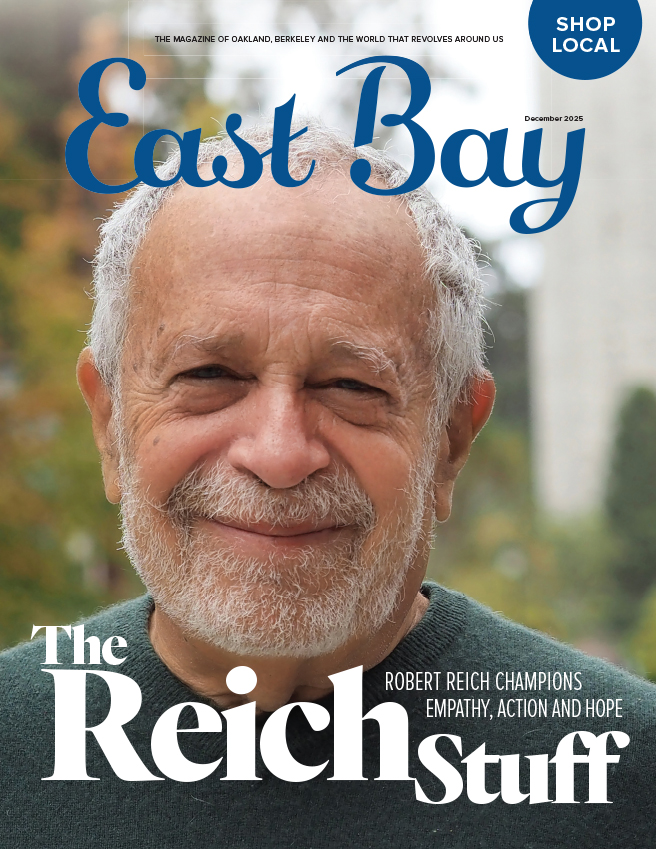Activist and filmmaker Stiv Wilson isn’t fighting to end plastic pollution. He’s fighting to end a system dependent on plastic. Can decades of work and a noteworthy cache of film awards make a drop of difference in an ocean of disposable everything?
A Ticket to the Show.
If you’ve ever been to the sagging Skates on the Bay restaurant in Berkeley, you know it’s a writer’s dream of a watering hole: A classic cocktail joint (of types both liquid and crustacean) on the waterfront, where the prices are Chicago-steakhouse comical, the service is more nostalgic than competent and the hipsters are in mercifully short supply. A few pebble skips away is the Berkeley Yacht Club and its members-only honor bar, reliably populated with colorful old salts downing rum drinks long after the barkeep has called it a night.
It’s here that Stiv Wilson, a gimlet-eyed environmental activist living on his sailboat, the Nurdle (yes, so named for the petrochemical industry pellets), in the Berkeley Marina, and I, a perennially uneasy executive and sometimes-editor, rediscover an intellectual kinship over soothing bay sunsets, one that has ebbed and flowed for well over a decade.
Once a green media founder, I’ve become a listless thirtysomething agency executive losing sleep over the acres of poly-whatever carpet our clients send to the landfill after an event. (Early in my tenure as a newly-minted C-suiter, I naively asked a young project manager what happens to all that fluffy acreage; surely we reuse it? “Don’t get me started,” he said with a sigh that was far beyond his years.) Stiv—oceanic nomad, activist, writer, nonprofit leader, policy wonk and societal saddle burr par excellence—is also a former media founder working on his biggest endeavor yet. I’m selling the floor covering; he’s covering the reason why.
In the midst of these Skates sessions, he’s in the Philippines one month, Indonesia the next, producing what will become a multi-award-winning—and, fair warning—emotionally gutting documentary tracing the global lifecycle of plastic. There’s a loose affiliation with the folks who over a decade ago brought us the Conjunction Junction-y sensation The Story of Stuff, but the funding, creation and production of The Story of Plastic is its own Wilson animal, with nary a drop of agency saccharine to be found. Remember those days? When we still wore those reduce, reuse, recycle blinders? Before our home-stretch ice melts, before talk of a Green New Deal, before abdicating from the Paris Agreement, before Trump?
Before it was possibly, then probably, too little, too late.
Stiv takes half a week holed up in Nurdle with a novel to recover after each trip, but not on account of jet-lag (the man is a house, and appears to have the physical stamina of a Marine). What he and his crew encounter will surprise even the most informed citizen; to experience its degrading extent is an unqualified shock. Barefoot children sorting through hazardous waste; waterways clogged with Trader Joe’s packets of flaxseeds and kale chips; the cancerous, mass incineration of humanity’s insatiable consumption:
“Look, we aren’t really talking about things being disposable,” Stiv says. “We’re talking about humans being disposable.”
Troubled waters ahead for this sailor: The suits-that-be who initially partner with Stiv for his formidable ability to get things done are experiencing not-insignificant anxiety around Stiv’s formidable ability to get things done. You don’t help Ban the Bag in an American city for the first time or pass national legislation to end microbeads by being easy on the (Powerpoint) slides. No matter: There’s a movement and a team of donors at his back. Stiv is quick to point out that the American romantic obsession with mavericks may seem sexy in the afterglow with a good cigarette, but in the thick of making real change, it’s as empty as a puff of smoke. He is adamant that we root out the desire to make lone-hero myths out of our causes.
With every shoot, the story becomes more textured and terrifying. For this writer, The Story of Plastic exists in another universe from the previous decade, where viral videos about going green are now almost eerily chipper, reflecting their context in the late-aughts, kid-glove approach consumer marketers seemed convinced could prevent the coming planetary catastrophe, if only we would buy enough sustainable cotton t-shirts or taste a vegan cupcake. “We’ve all learned what an externality is! Now go be a green consumer and drink some organic milk!”
Well, we do drink.
Fast Forward and Flashbacks.
Stiv carefully turns over my question of whether he’s anti-establishment. “No, I don’t see it that way,” he says. “That’s the whole, intractable problem. That’s just all of us butting up against neoliberalism. I’m not here to change the system; I’m here to make a new one.”
When I ask if we can hope to change things from the inside, I am really asking: Do we have a choice, anyway? Do we give our good, green names to corporations destroying our chance at a hospitable future, in the hopes that any awareness is better than none at all? Stiv will be the first to tell you to get expert at, though never comfortable with, these complexities; at least in the world of policy, nothing gets done if you don’t.
What of the rest of us? The eco-publicist hawking mineral eye shadow for money who drives her gas-guzzler home at night and gorges on industrial candy fortified with that other “mineral,” a food-grade petroleum derivative that comes in a single-use bag. The vegetarian who raises several offspring and buys their mass-produced polyester school clothes on discount from TJ Maxx and picks a fight at the family BBQ over the same spatula being used to flip both the bloody burgers and the Impossible ones.
“Just the privilege of choosing to eat vegan, when I’ve seen fathers holding their infants during a nap in a methane-suffused waste dump; where my camera is worth more than he’ll make in his entire life? It’s completely the wrong conversation,” Stiv says.
This problem shows up as the film’s lone incongruity, where thoughtfully-built pacing and human-focused storytelling are ever-so-gently blemished by the interstitial scenes providing explainer animations. They feel sprinkled in, like pre-packaged sustainability seasoning for the bygone Western palate of 2007.
The heartache is that we’re a half century on from the facts beginning their mainstream spill, and I’m still pulling my family’s plastic flaxseed packets out of the recycling bin.
To err is human; to escape plastic, impossible.
Stiv and I connected on Facebook around 2006, when everyone was following anything and “friending” anyone who had so-called common interests. (The end of civilization? Discuss.) He was the co-founder and editor-in-chief at Wend Magazine.
“Wend wasn’t environmentalist, per se,” he says. “It was more about honoring outdoor adventure in a way that was accessible and authentic. In capitalism, everything becomes commodified, even the outdoors. At that time it was all about elite athletes and if you had the latest Patagonia jacket. But you can’t be a skater, a surfer, a climber, an expeditioner, a sailor—any of these things—and not feel a connection to the earth. Just from an aesthetic standpoint alone, the ugly incongruency of things like consumerism and litter offended me.”
His transformation to a full-blown activist was cemented when he was invited to a Surfrider Foundation meeting many years ago. “I was living in Portland and my wife at the time, Molly Kramer, was a brilliant activist,” he says. “She happened to connect me to the foundation, and it just took off from there.”
Stiv says he knew he would never be elite at surfing, and besides, surfer culture wasn’t quite a fit. It was time to find something where he could make a dent. He recalls observing a disorganized but inspiring session at his first Surfrider meeting; he was fascinated by this “mythical plastic garbage patch.” Emboldened, at the second one, “I kind of just blew things up. I said: What if we just banned plastic bags in Portland?”
Being thrown into the deep end takes on a whole new meaning in the world of policy.
Stiv recounts dozens of collaborative efforts with hundreds of people across different states and eventually, countries; many were successful—some not—but that’s another article. In the end, among the most well-known campaigns, the Ban the Bag team won Portland.
The lessons? “People are motivated if something they love is in danger,” he says. “I learned this working on activism with the Great Lakes. It’s hard for someone in the Midwest to care about the ocean, because they’re not by the ocean. But everyone—and I speak for myself, too, as a Midwestern boy—loves the Lakes. No matter what: You cannot be afraid to fail; you have to collaborate; and most of all you have to focus on what people love. Love moves any human, anywhere.”
By 2010 (to his best recollection), Stiv had departed Wend to work on “the patch.”
Meanwhile, I was a rising editor in the early days of blogs, and I’d been an environmentalist since my youth. It was only a matter of time before my first funded venture, a green lifestyle media brand, was born in 2007. In those days, green media was the right kind of hot, and a tight-knit collective of writers, editors and marketers emerged.
But back to “the patch.” The first thing to know is that there are actually five of them around the world. (Patch, for me, calls to mind Buzzfeed’s quiz, “What Kind of Pocket Are You?” Patches! So cute!). They’re more accurately known as gyres, for the second thing to know is that they’re not so much stay-in-their-lane floating platforms as loose, country-sized galaxies, relentlessly spreading every kind of lethal trash imaginable, from the toxically nanoscopic to the sorts of objects that might give David Geffen yacht envy.
If that thought horrifies, realize that what is happening in Southeast Asia—what The Story of Plastic documents—is far, far worse. The Western world made a happy business of sending much of its garbage to China; when China became tired of it, Southeast Asia became the next trash bin.
After 13 voyages and 35,000 nautical miles at sea in all with the group in both the Atlantic and the Pacific, and signing on as the communications head at the 5Gyres Project, a nonprofit devoted to gyre plastic research and ocean advocacy, Stiv never stopped writing. Thus, the new media brand promoting sustainable décor and nontoxic living also began featuring astonishing photojournalism. He used to wire me his stories from the middle of one ocean or another, tapping out each word patiently on his phone from his swaying cabin, occasionally finding a strong enough connection to include an image. One could easily forgive the typos.
These reports from the field continue. During the Deepwater Horizon catastrophe, Stiv found a way to get to the Gulf at no expense to our investors; talked himself onto a BP helicopter; and talked himself out of a fight (I’m told) once he’d been busted mid-flight. The photos and essays that resulted remain some of the best environmental work I’ve ever published.
Though he is widely respected in both policy and progressive circles, Stiv is also a notorious contrarian—not the “Well, actually” basement dweller cliché you find claiming an advanced philosophy degree in a fruitless whataboutism argument on Twitter, but the uncomfortably prescient kind. Like anyone trying to change the world, his ego can at times endearingly outstrip his height. As a longtime comrade, I know this tends to mortify him; underneath the infamous indignation is a heroic and humble heart. “I don’t want to be seen as a hero, period,” he says. “It goes against everything I believe. I feel for the underdog because I was an underdog as a kid. And when I went to the Philippines, I knew I was going to tell this story—but not from my perspective. The problem in a lot of storytelling is that it is well-meaning but it can serve to further entrench colonialism.”
Was growing up an underdog what formed your moral fiber, I ask?
“My code of ethics was truly formed by skateboarding,” he says, and I can hear the love in his voice. “At the time, it was a countercultural thing populated by misfits writing anti-establishment philosophy in Thrasher Magazine. Now it’s a more extreme sport, but when I was a kid it was more a philosophy and way of being that was not the norm.”
He continues: “It was all about trying, and it was so supportive. As long as you tried, that’s all that mattered. Not your background, not your clothes, not your looks. School sports were all about elevating the hero, but skateboarding was about helping everyone succeed. I was so drawn to this. Being out in front can be inspiring, but it can also be narcissistic and alienating. Skateboarding was like, safety in numbers, camaraderie, giving cover, because you need it. It was so different from this patriarchal, superstar, cool-at-all-costs, demeaning culture we live in.”
Fish in a Barrel.
At our standing Friday Skates sessions, Stiv makes a point never to order the fish, no matter if it’s been lovingly shepherded in wild eelgrass like some seawater analog to a prized Japanese steer. Our oceans are overfished, end of story. There’s also the unpalatable truth that every time you eat fish, of course, you’re eating plastic. Remember in the 2007 documentary King Corn, when our endearingly curious East Coast college protagonists move to corn country only to learn their very DNA is, well, corny?
“It’s like the myth your parents scared you with about gum staying in your stomach for years if you swallowed it, except this is actually true,” Stiv says. He goes for the day’s pasta. I choose the oysters. Oysters are fine, right? (Not really.)
The film is made. It is wholly deserving of the accolades, reviews, awards—a dozen or so and counting at press time, including the esteemed 2020 John de Graaf Environmental Filmmaking Award.
From the Wall Street Journal:
“Earth Day turns 50 on Wednesday amid a landfill’s worth of commemorative TV programming both on and around the date, including marathons on BBC America and National Geographic/Disney. Much of it will be a celebration, either of nature or environmentalists. The Story of Plastic, however, will bring both parents and children up short, and not just by the extent of the pollution it examines, but where it ultimately puts the blame: on them.”
When you’re pissing off the WSJ, you’re definitely doing something right. (The film does nothing of the sort; the blame is squarely placed on industry.)
More accurately, the Environmental Film Festival writes:
“Unlike any other plastic documentary you’ve seen, The Story of Plastic presents a cohesive timeline of how we got to our current global plastic pollution crisis and how the oil and gas industry has successfully manipulated the narrative around it.”
When the credits roll after my first watch, I suddenly remember a dinner with a leading environmentalist investor in San Francisco’s Pacific Heights neighborhood in 2012. “Are we fucked?” he asks me. “We’re fucked,” I say, and we slip from our chairs without another word; an ecological Irish goodbye, two ships passing in Planet Earth’s night.
As for The Story of Plastic, a consumer-friendly Pixarian promotional website soon follows. The marketers still believe.
Does Stiv?
“My partner, Marissa, and I just had twin girls, and we named them Ocean and Forest—because these things are important,” he says. “There’s real meaning. There’s power. There’s hope—but hope is not a strategy. So I believe in elevating voices and building strategy, because I have to.”
And so do we.











